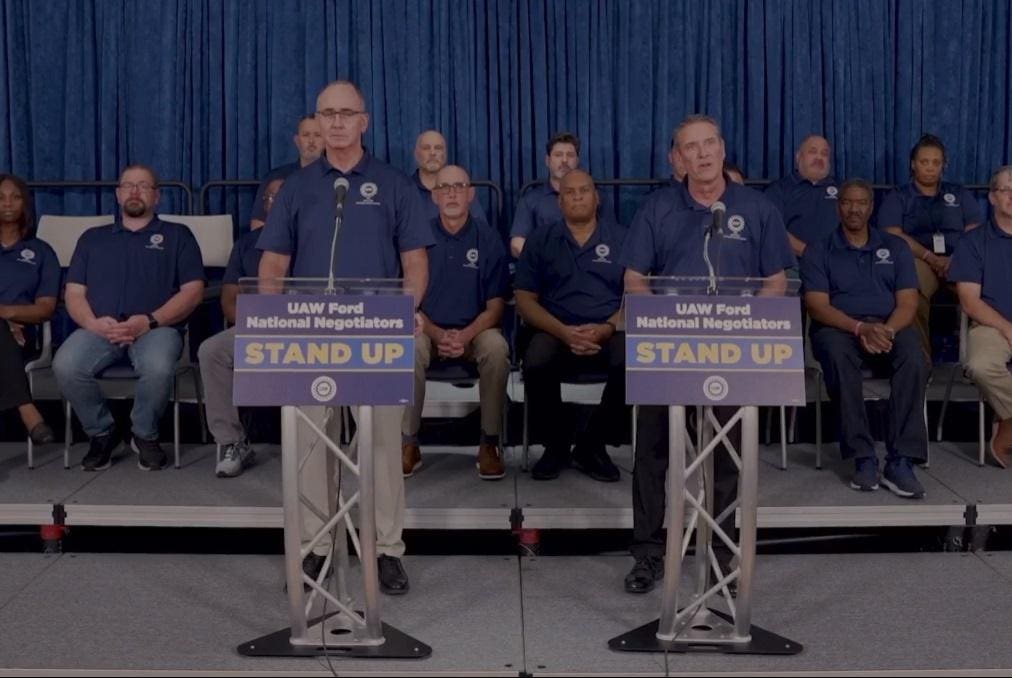When Ford Motor Co. UAW workers vote later this week they’ll be considering a longer, richer contract that includes the right to unionize workers at planned electric vehicle and battery plants, converts temporary workers to permanent hires more quickly and reduces by more than half the time it takes to reach top wages.
Those are some of the highlights UAW president Shawn Fain and UAW vice president Chuck Browning outlined for members during a live webcast Sunday night ahead of ratification votes expected to take place within days.
Specifically, the terms of the agreement include:
- 25% increase in general wage increases-GWI
- 11% Immediately 3% in October 2024
- 3% in October 2025
- 3% in October 2026
- 5% in October 2027
- Including cost of living allowances top wage rate for production workers increase from $32.05/hour to $42.60 by the end of the contract
- Top wage rate for skilled trades increases from $36.96/hour to $50.57 by end of the contract
- Progression to top wage rate reduced from eight years to three
Those are some of the top line economic gains. In depth details are available on the UAW website.
“At ratification Ford workers will receive an immediate 11% wage increase,” said Browning. “That almost equal to all the wage increases since 2007.”
A major concern for the UAW has been the right to include workers at new electric vehicle and battery plants under its master agreement and the union succeeded in winning that right with Ford.
“We’ve secured a pathway for thousands of EV and battery jobs to come under our master agreement at master agreement wages,” said Fain.
The battery plant planned for Marshall, Mich. Will include transfer rights for any “surplus” Ford workers and come under the master agreement after a card check process.
In addition, the Tennessee Electric Vehicle Center in Memphis, Tenn. will also have transfer right for surplus Ford UAW members and would come under the master agreement as soon as a majority of its workforce is comprised of UAW members, Fain explained.
Perhaps the most novel of changes is the lengthening of the contract an additional six months from the normal four years. In this case, if ratified, the contract would expire on April 30, 2028.
That wasn’t a date randomly chosen, but, Fain explained, rather to allow the union to strike, if necessary, on the traditional May Day or International Workers Day.
“Even though May Day has its roots here in the United States, it is widely celebrated by workers all over the world. It’s more than just a day of commemoration. It’s a call to action,” said Fain. He went on to suggest other unions use that day to stage strike.
“Secondly, we demanded a longer contract because one of our biggest goals coming out of this historic contract victory is to organize like we’ve never organized before,” Fain continued. “When we return to the bargaining table and 2028 it won’t just be with the big three but with a big five or big six.”
Meetings will be held at UAW locals around the country to further explain the terms of the proposed contract as well as answer questions, followed by voting by members on whether or not to ratify the deal.
“No matter what you decide, this contract remains a huge victory,” Fain concluded in his webcast message to members. “This contract is about more than just economic gains for auto workers. It’s a turning point in the class war that’s been raging in this country for the past 40 years.”
The UAW will go through a similar process with its members who work for Stellantis after the two sides reached a tentative agreement on Saturday, but negotations are still underway with General Motors Co.
Read the full article here





